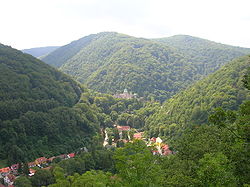Great Plain and North
Great Plain and North
Észak és Alföld | |
|---|---|
Region | |
 Great Plain and North (NUTS 1) and its constituent counties (NUTS 3) | |
| Country | |
| Capital city | Budapest |
| Area | |
| • Total | 50,000 km2 (20,000 sq mi) |
| Population | |
| • Total | 4,200,000 |
| • Density | 84/km2 (220/sq mi) |
| Time zone | UTC+1 (CET) |
| • Summer (DST) | UTC+2 (CEST) |
| NUTS code | HU3 |
Great Plain and North is a statistical (NUTS 1) region of Hungary. It comprises the NUTS 2 regions of Northern Hungary, Northern Great Plain, and Southern Great Plain.
The total population of the region is around 4,200,000 people in an area of 50,000 km2 (19,000 sq mi) (giving a population density of around 84/km2 (218/sq mi).
Regions and counties
There are nine counties in Great Plain and North, which are in three statistical regions:
- Northern Hungary (HU31) (Borsod-Abaúj-Zemplén County, Heves County and Nógrád County)
- Northern Great Plain (HU32) (Hajdú-Bihar County, Jász-Nagykun-Szolnok County and Szabolcs-Szatmár-Bereg County)
- Southern Great Plain (HU33) (Bács-Kiskun County, Békés County and Csongrád County)
Northern Hungary and Northern Great Plain are often together called North-Eastern Hungary.
Geography
This section needs expansion. You can help by adding to it. (December 2009) |
Geographical features
Prominent landscape features are the North Hungarian Mountains and the Great Plain
Rivers and lakes
This section is empty. You can help by adding to it. (December 2009) |
National Parks
Tourism

There are four tourists regions in the Great Plain and North. The Lake Tisza and its surrounding is an exceptional region as it is not part of the NUTS.
The four regions are:
Landmarks by region
Northern Hungary
The most important tourist cities are Eger, Miskolc, Sárospatak, Pásztó, which are all famous for their wines and spas. Tokaj) and Hollókő form part of a World Heritage Site. There are many mediaeval castles and ruins of others, including Boldogkő Castle, Castle of Diósgyőr, Füzér Castle, Sárospatak Castle, Szerencs Castle, Szécsény Castle estates, and Hollókő Castle. The Mátra mountains and the Bükk mountains give plenty of opportunities for hiking, and there are areas of outstandingly beautiful countryside in Lillafüred and Aggtelek National Park. The caves in the Bükk have many stalagmites and stalactites.
Northern Great Plain

The most important tourist sites are the regional seat Debrecen with its ancient monuments, and Hortobágy National Park. Nyíregyháza and Nyírbátor both have intimate historic city centres. Nyíregyháza and its suburbs have some interesting sights, for example the open air museum, safari park, and Nyírvidék children's railway. There are extraordinary churches in Csaroda and Tákos.
Lake Tisza
Southern Great Plain
The most important tourist sights are the Great Plain itself, unspoiled landscape, romantic farms, the ethnographic memories and traditions and the cities' monuments and museums, especially Szeged the regional seat, Gyula, Kecskemét, Kalocsa, Szentes, Hódmezővásárhely, and Baja. The region's most important landscapes include the Ópusztaszer National Heritage Park, Gyula Castle, the stud farm in Mezőhegyes and the wine cellars at Hajós. Other attractions include the Great Bustard Nature Reserve at Dévaványa, the Bugac Plain, and the Mártély National Park.
The most popular festival in the region is the Szeged Open Air Games, featuring historical reenactments and ancient sports such as archery.
External links
- http://akademia.miert.ro/downloads/miert3/baranyi.doc - Béla Baranyi: Regions of Europe (in Hungarian)
- János Rechnitzer: the Unseen World of the Great Plain and North (Origo.hu) (in Hungarian)
References
